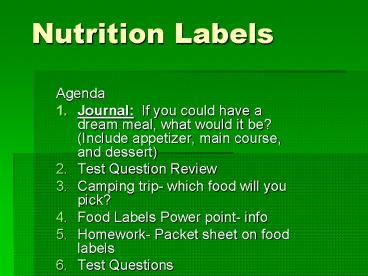Nutrition Labels - PowerPoint PPT Presentation
Title:
Nutrition Labels
Description:
Nutrition Day 4- Labels Agenda Journal: If you could have a dream meal, what would it be? (Include appetizer, main course, and dessert) Test Question Review – PowerPoint PPT presentation
Number of Views:102
Avg rating:3.0/5.0
Title: Nutrition Labels
1
Nutrition Labels
- Agenda
- Journal If you could have a dream meal, what
would it be? (Include appetizer, main course, and
dessert) - Test Question Review
- Camping trip- which food will you pick?
- Food Labels Power point- info
- Homework- Packet sheet on food labels
- Test Questions
2
Test Question Review
- 1. How many grains should we make whole grain
in our diet? - A. 1/3 of our daily diet
- B. ½ of our daily diet
- C. 1 cup per day
- 2. What was the website we used in class to
learn about the Food Pyramid? - www.choosemyplate.gov
- .
3
Test Questions Review Continued
- 1. What is the importance of the stairs on the
side of the food pyramid? - Exercise
- 2. Match the food group with its color.
- Orange, Green, Red, Yellow, Blue and Purple.
- 3. Why do we have oils/fats in our diet?
- Good for our brain
4
Whats In A Label?
Item 1
- Item 1 Light tuna, water, vegetable broth, salt
- Item 2 Meat by-products, ocean whitefish, fish,
water, tuna, titanium dioxide, guar gum,
potassium chloride, salt, vitamins (E, thiamine,
monoitrate, niacin, D. calcium, A, Folic acid,
B12, D3), Red 3, minerals (ferrous sulfate, zinc
oxide, managanous oxide, copper sulfate, calcium
iodate, sodium selenite). - Item 3 Mechanically separated chicken, water,
beef, pork, salt, corn syrup, spices, dried
garlic, sodium nitrite. - Item 4 Chicken, Pork, Water, beef, Salt, Corn
syrup, Solids, Dextrose, sodium Phosphates,
Paprika, Sodium Erythorbate, Sodium Nitrite,
Garlic powder. - Item 5 Enriched corn meal, Vegetable oil, Salt,
Corn starch, Onion powder, sugar, Soy, Flour,
Buttermilk, maltodextrin, hydrolyzed soy protein,
monosodium glutamate, dextrose, garlic powder,
artificial colors, spice and natural flavors. - Item 6 Milled corn, sugar, malt flavoring, high
fructose, corn syrup, salt, sodium, ascorbic
acid, Vitamin B6, B2, A, B1, D - Item 7 Sugar, corn syrup, wheat flour, molasses,
caramel color, Licorice, Corn starch, Salt,
Artificial colors, resinous glaze, anise oil,
Canaba wax. - Item 8 Calcium Carbonate, Magnesium, hydroxide,
dextrose, flavoring magnesium, Sterate,
Polyethylene glycol, pre-gelatinized starch and
sucrose.
Item 2
Item 3
Item4
Item 5
Item 6
Item 7
Item 8
5
Nutritional Facts Label
Serving Size The amount you should eat in one
sitting.
Servings per container How many servings are in
the container.
6
Nutritional Facts Label
Calories Units of energy
7
Nutritional Facts Label
Daily Value The percent of the nutrient found
in one serving based on the total amount you are
supposed to have in one day.
8
Nutritional Facts Label
Total Fat The total amount of fats found in one
serving.
Saturated Fats fat that consists of
triglycerides containing only saturated fatty
acids. It is usually solid at room
temperature. EX. Foods that contain a high
proportion of saturated fat are butter, lard,
coconut oil, dairy products like cream and
cheese, meat, and chocolate.
Unsaturated Fats is a fat or fatty acid in which
there are one or more double bonds in the fatty
acid chain. It is usually liquid at room
temperature. EX. Common unsaturated fats are
derived from oily fish such as herring, tuna,
sardines, and salmon as well as from vegetable
oils and nuts.
Trans Fats Most trans fats consumed today are
industrially created by partially hydrogenating
plant oils
9
Nutritional Facts Label
Carbohydrate are the body's main source of fuel
(glucose) for energy.
10
Nutritional Facts Label
11
HomeworkFood Labels
- Complete the Food Label Worksheet in your
packet. - You can use the sample label given to you in
class, or you must use your own from home and
bring it in.
12
Test QuestionsFood Labels
- 1. What is a calorie?
- Unit of energy
- 2. The percent daily value on food labels are
usually based on a___calorie diet? - 2,000
- 3. What does the percent daily value tell us
about nutrients on a food label? - How much of that nutrient is in the package of
food - How much of that nutrient you should have in one
day - The percent of the nutrient found in one serving
based on the total amount you are supposed to
have in one day - 4. What does serving size tell us about a food
item? - How much you should eat in one sitting.
- 5. How can food companies make their food look
healthier using the serving size? - They make them smaller.































